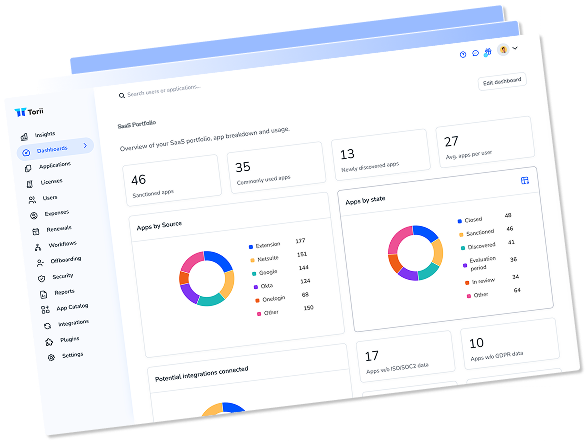“Efficiency is doing things right; effectiveness is doing the right things.” — Peter Drucker
The Operations team is the backbone and nervous system of any company, adding structure and connectivity between different nodes of the organization. Their obsession? Ensuring everything is linked elegantly (if possible) to maximize efficiency and efficacy.
However, today’s list of “things” to connect is miles long, and the extent to which technical debt undermines their progress is equally massive.
So, an IT professional seeking to build a bridge with Operations leadership must know precisely what you are getting yourself into. In Operations, you’ll find some of the organization’s brightest and most innovative people, but you will also find busy professionals who don’t have time to listen to nonsense. That’s where this guide can help. You’ll learn a bit more about their priorities, responsibilities, and how you can get buy-in for your next project—whether that’s SaaS Management or something else.
If that sounds useful, then let’s dive in.
Operations Professionals: The Orchestrators
What they care about: Operational efficiency, cost reduction, process optimization, scalability, and alignment.
Every team claims to be data-driven, but only a few consistently are—Operations is one such group. And that’s not an accident; it results from the kind of people who gravitate to ops. Generally, Operations professionals interact in the margins between teams, looking for insights and patterns that reinforce or cut against narratives that different departments might believe and repeat. Often, Ops leaders have a unique amount of power and responsibility to find equitable solutions to problems of process, cost management, scalability, and alignment. That means that they constantly seek numbers that can inform their strategic decisions in an accurate and defensible way.
If you want to build a bridge of trust with an Operations team lead, you’ll need solid data and a strong sense of strategic alignment within the organization. If you prove that you think critically about these things, you’ll be more likely to catch the attention of and build the trust of an operations team leader. Here are some things to remember.
Talk Outcomes—Not Features (yet)
One common pitfall in gaining buy-in is to use the language of capabilities or features rather than outcomes. A feature is something a tool can do; an outcome is how it affects your organization. While the feature might be necessary, it is only valuable within the greater context of your organization’s success. No one understands that better than Operations.
If you want to earn buy-in for a SaaS Management Platform or any other initiative, you must know the following information:
- What are the problems this solves?
- What are the opportunities this capitalizes on?
- How does this fit within the greater structure of our organization?
- Will this help us to save money, scale a process, reduce risk, etc?
Operations Leaders are interested in tangible outcomes. Focusing on how an SMP delivers these results will make your proposal more compelling.
Finding the Outcomes that Matter
Not all positive outcomes carry the same weight. Identifying which benefits align with the organization’s operational goals is crucial. An SMP is a powerful tool with a broad spectrum of use cases—but that means you’ll have the most success if you understand which ones are the most important to your organization.
Operational Frameworks
One way to do that is to understand the operational frameworks that help your IT team prioritize different business outcomes. Some popular ones include:
- Lean and Six Sigma (Often combined as Lean Six Sigma [LSS])
- ISO 9001 (Quality Management Systems)
- Balanced Scorecard
- Kaizen (Continuous Improvement)
- APQC’s Process Classification Framework (PCF)
The important part is not which framework is used, but what that framework demonstrates about their prioritization. For example, Lean Six Sigma and Kaizen prioritize efficiency and waste reduction while Process Classification Framework focuses on standardizing processes and benchmarking. In each case, the target business outcome will be slightly different and so should your corresponding emphasis on value. For example:
- Enhancing Efficiency and Reducing Costs: An SMP aligns with Lean principles by identifying and eliminating unused or redundant SaaS applications, reducing waste and optimizing resource utilization.
- Improving Quality and Compliance: An SMP provides security and compliance insight into other applications’ certification status while recording and audit trail for workflows. This supports ISO 9001 compliance, ensuring that processes meet quality standards and regulatory requirements.
- Strategic Alignment and Performance Monitoring: With real-time data and analytics, an SMP contributes to the Balanced Scorecard approach, allowing Operations leaders to track performance against strategic objectives and make informed decisions.
- Fostering Continuous Improvement: An SMP facilitates Kaizen by enabling various automation for ongoing monitoring and providing insights that lead to incremental enhancements in processes and tool usage.
- Standardizing Processes and Enabling Benchmarking: By aligning SaaS applications with the APQC’s PCF, an SMP helps standardize processes across departments, making it easier to benchmark performance and identify areas for improvement.
At the end of this piece, we’ll provide more examples for how to tailor your SaaS Management initiative based on the primary framework your operations team uses.
What Operational Challenges MUST You Address?
Another tactic for finding the best business outcome to tackle is identifying the urgent operational hurdles. If you can identify the system issues that hinder efficiency, you can talk about the outcomes an SMP can provide that resonate most with operations leadership. These might include:
“We spend too much money on SaaS.”
If you’re trying to cut costs, SaaS licenses offer a massive opportunity—organizations often over-provision expensive software by 30% or more. An SMP provides tools and insights to drop costs, help during renewals, and determine which apps matter.
“User app adoption is low.”
This might be due to a lack of training or a preference for shadow IT in the company. An SMP can give you insight into which tools they actually use daily. This data can inform strategic decisions to save costs, streamline the SaaS stack, reduce risk, and more.
“We spend too much time on manual processes related to SaaS administration.”
This is a common issue for Operations. Manual tasks bog down your work and lead to higher error rates. An SMP can automate tasks around contract management, shadow IT detection, onboarding and offboarding, app lifecycle management, and so much more.
“We don’t have enough data during renewal negotiations.”
The best way to save money is to perfect your contract management. Automated notifications, real-time usage data, and benchmarking can provide the data you need for a favorable renewal.
“We struggle with SaaS sprawl and shadow IT adoption.”
The average organization has 600 apps, and only a fraction of them are known or used regularly. This causes incredible bloat, security risk, and financial waste. However, to Operations, it also represents missing pieces in the technology puzzle.
Putting it all together—sample message:
Ok, you’re now equipped with a better understanding of your Ops team’s priorities and how you might help them achieve their goals. But how do you start the conversation?
First, know your contact.
Figure out who can back up this initiative and who would benefit from its success. An excellent contact would be someone who sees this technology as a way to align IT with Operation’s strategic initiatives better. Some example contacts would be the company’s Chief Operations Officer (COO), Director of Operations, or the VP of Operations.
Existing rapport is best.
If you’ve shown a reputation for commitment to projects and reliability, you will have much more success when asking for support. After all, no one wants to back an erratic project owner.
Structure your message.
You’ve heard it before, but when you write a message to your teammate, you want to get to the point quickly. (They’re busy, remember). Use this template to structure your message:
Sample Message to Operations Leadership
Hi [Name],
I've been thinking about how our departments can collaborate to enhance our organization's operational efficiency.
With the increasing adoption of SaaS applications across the company, we share a challenge in optimizing processes, controlling costs, and ensuring that our tools align with our strategic goals.
By jointly mapping our SaaS landscape, I believe we can gain better visibility into the applications we use, eliminate redundancies, and identify opportunities to streamline workflows.
This collaboration could help us implement best practices outlined in frameworks like [preferred framework] enhancing our teams' effectiveness.
We’ve seen a sharp rise in the number of new applications adopted outside official procurement channels, so it’s essential to take steps and address this soon.
Would you be open to meeting next week to discuss this further?
Thanks for considering this, and I look forward to working together on this.
Best,
[Your Name]
Breaking Walls—Building Bridges
Operations hate silos. By reaching out in a collaborative spirit, you’ll demonstrate a willingness to work together on an important project that both teams will appreciate. Just remember:
- Keep it relevant
- Focus on outcomes—not features
- Show empathy for their priorities and pains
- Encourage dialogue
By building bridges with other teams, you improve, not only your chances of buy-in but also your standing within the company. In time, you’ll be seen as a leader willing to work with others and drive innovative solutions that directly impact company priorities.
Good luck!
Bonus Insights: Key Operational Frameworks:
- Lean and Six Sigma:
- Focus: Eliminating waste (Lean) and reducing process variation to improve quality (Six Sigma).
- Business Outcomes: Increased efficiency, reduced costs, and enhanced quality.
- SMP Alignment: An SMP identifies redundant or underutilized SaaS applications, eliminating waste associated with unnecessary spending. It provides data analytics to monitor usage patterns, helping reduce variability in processes supported by SaaS tools.
- ISO 9001 (Quality Management Systems):
- Focus: Meeting customer and regulatory requirements through a robust quality management system, emphasizing continuous improvement.
- Business Outcomes: Improved customer satisfaction, compliance adherence, and consistent quality across processes.
- SMP Alignment: An SMP aids in documenting processes and maintaining accurate records of SaaS application usage, configurations, and changes. This supports compliance with ISO 9001 requirements and facilitates audits. Providing insights into application performance fosters continuous improvement in operational processes.
- Balanced Scorecard:
- Focus: Aligning business activities with the organization’s vision and strategy, and monitoring performance against strategic goals across financial, customer, internal processes, and learning perspectives.
- Business Outcomes: Strategic alignment, performance improvement, and better decision-making.
- SMP Alignment: An SMP delivers data that feeds into key performance indicators (KPIs), particularly regarding operational efficiency and resource utilization. It helps track SaaS spending (financial perspective), enhances process efficiency (internal processes), improves employee productivity by providing the right tools (learning and growth), and ultimately contributes to better customer service.
- Kaizen (Continuous Improvement):
- Focus: Continuous, incremental improvement involving all employees.
- Business Outcomes: Enhanced efficiency, employee engagement, and sustained operational excellence.
- SMP Alignment: By providing transparency into SaaS usage and performance, an SMP empowers employees to identify inefficiencies and suggest improvements. It supports a culture of continuous improvement by enabling quick adjustments and optimizations in SaaS deployments.
- APQC’s Process Classification Framework (PCF):
- Focus: Providing a standardized taxonomy of business processes for benchmarking and improvement.
- Business Outcomes: Process standardization, benchmarking capabilities, and identification of optimization opportunities.
- SMP Alignment: An SMP can map SaaS applications to specific business processes within the PCF, highlighting redundancies and gaps. This enables Operations teams to standardize tool usage across the organization and streamline workflows.

